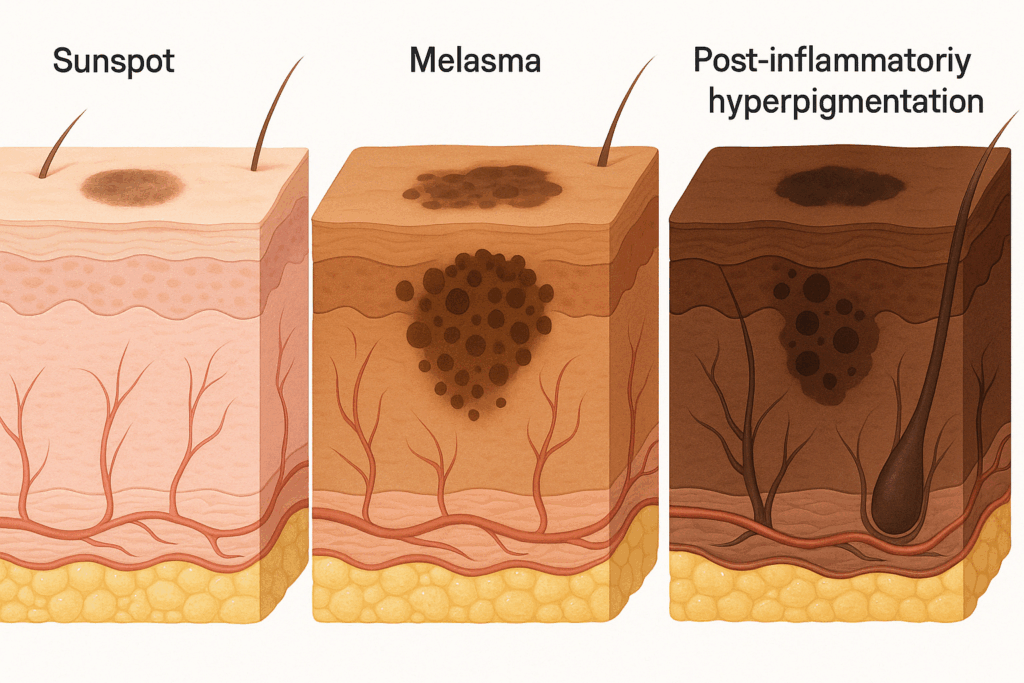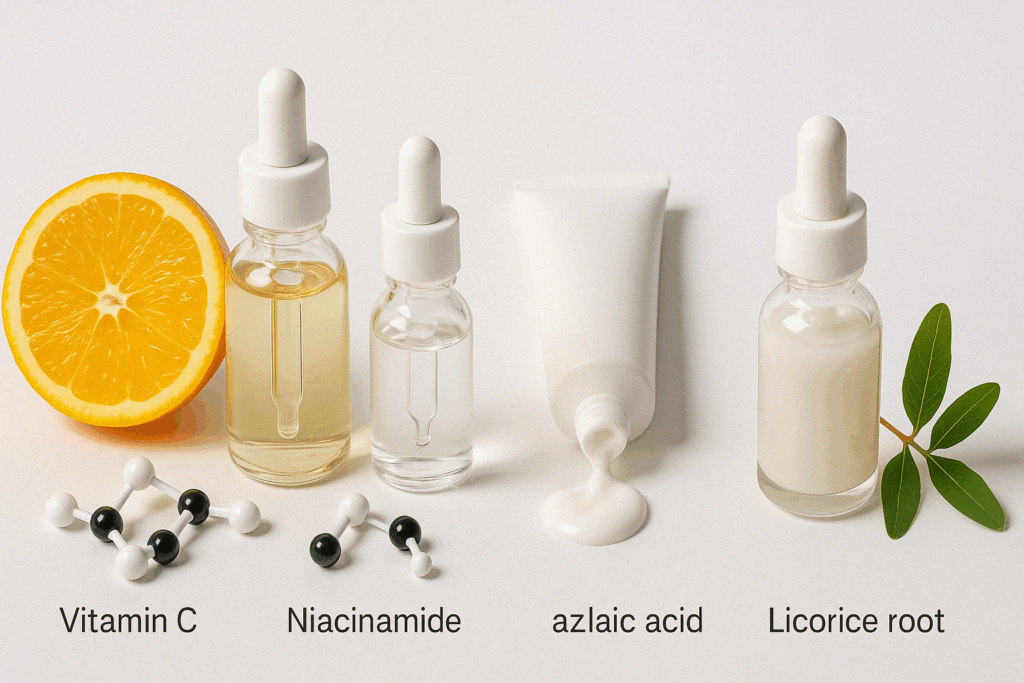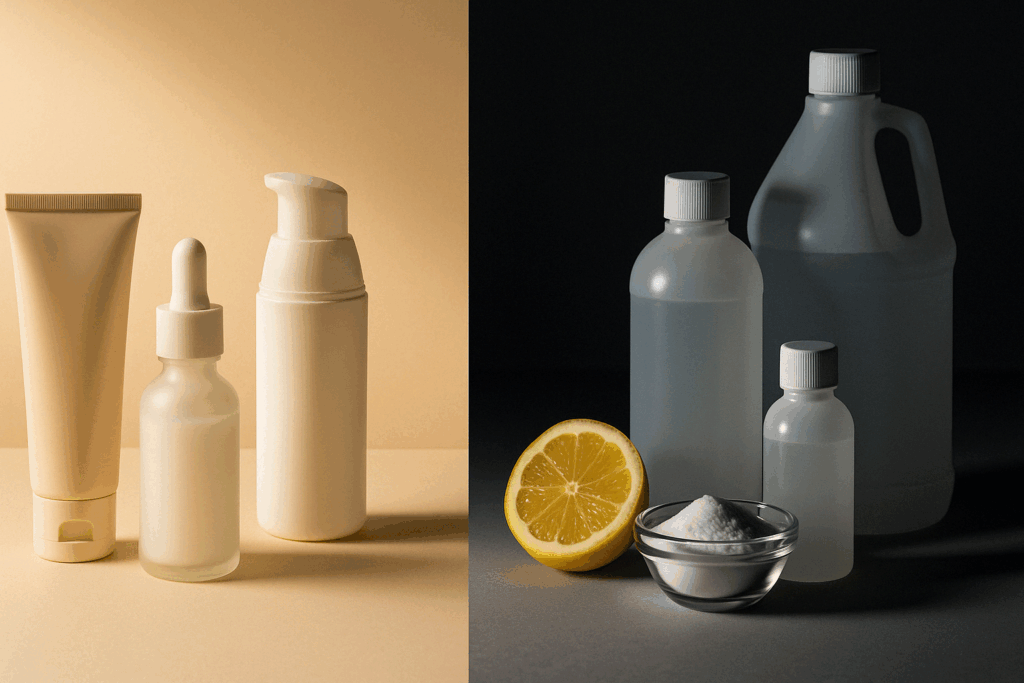Across the expanding landscape of skincare, the challenge of hyperpigmentation remains one of the most common and frustrating concerns faced by individuals of all skin types and tones. Dark spots—also known as age spots, sun spots, post-inflammatory hyperpigmentation (PIH), or melasma—often arise from a confluence of causes including sun exposure, hormonal changes, acne scarring, and inflammation. Despite their ubiquity, misconceptions persist regarding their treatment. The market is flooded with products that promise rapid results, but few are backed by robust dermatological science. For health-conscious consumers navigating this crowded field, choosing a safe and effective dark spot remover requires a thoughtful, informed approach grounded in expertise and evidence.
You may also like: How to Choose Skin Care for Fine Lines: Evidence-Based Tips for Healthier, Younger-Looking Skin

Understanding Dark Spots: Origins and Types of Hyperpigmentation
Dark spots are primarily the result of melanin overproduction, the pigment that gives skin its color. This overproduction may be triggered by various stimuli such as ultraviolet (UV) radiation, hormonal shifts, or skin injury. Post-inflammatory hyperpigmentation, for example, often follows acne, eczema, or insect bites and is more common in individuals with medium to dark skin tones. In contrast, lentigines—often referred to as age or sun spots—typically occur in fairer skin after chronic sun exposure. Melasma presents a distinct clinical picture, often influenced by hormones, appearing in symmetrical patches on the face.
Each type of dark spot necessitates a tailored treatment strategy. A face black mark remover that works well for acne-induced hyperpigmentation may not be suitable for melasma, which often requires medical supervision and long-term treatment plans. Recognizing the difference between these types helps consumers avoid ineffective or potentially irritating solutions and instead focus on finding a scientifically appropriate dark spot solution.

The Science Behind Safe Dark Spot Removers
Safe and effective dark spot removers rely on active ingredients that have been studied and approved by dermatological bodies or peer-reviewed research. Among the most established ingredients is hydroquinone, a skin-lightening agent that inhibits melanin synthesis. However, hydroquinone’s use is highly regulated in many countries due to potential side effects, including irritation and ochronosis with prolonged use. For those seeking safer alternatives, ingredients like niacinamide, vitamin C, kojic acid, azelaic acid, and licorice root extract offer promising results with fewer adverse effects.
Azelaic acid, for instance, has shown efficacy in reducing both acne and PIH, making it a multifunctional agent particularly helpful for those dealing with acne-related pigmentation. Vitamin C, especially in stable forms like ascorbyl glucoside, acts as an antioxidant that can brighten skin while neutralizing oxidative stress. These agents, when included in a dermatologically formulated dark spot clearing cream, not only target hyperpigmentation but also enhance overall skin tone, offering users both functional and aesthetic benefits.
How to Read a Skincare Label Like a Dermatologist
Understanding the contents of a product label is a vital skill for anyone seeking an effective dark spot remover. Many products advertise their effects with enticing phrases, but the true efficacy lies in the ingredient list and its formulation. A reputable black spot corrector cream will disclose active ingredients and their concentrations. For instance, a product containing 10% niacinamide will have a more pronounced brightening effect than one with only 2%.
Consumers should be wary of formulations that include fragrances, dyes, or alcohols, particularly if they have sensitive or acne-prone skin. These additives can cause inflammation that may exacerbate hyperpigmentation. Dermatologists also advise looking for products that are non-comedogenic, hypoallergenic, and tested by independent laboratories. Products with clinical testing or that have been reviewed in dermatological journals are preferable over those with anecdotal claims or influencer endorsements alone.

Avoiding the Pitfalls of Irritating or Unsafe Treatments
The rise of do-it-yourself skincare trends and over-the-counter bleaching products has unfortunately led to increased reports of contact dermatitis, chemical burns, and paradoxical skin darkening. Harsh agents like undiluted lemon juice, baking soda scrubs, or unregulated imported creams often contain corticosteroids or mercury compounds, which can cause irreversible skin damage. These products not only fail to function as a safe dark spot solution but can also disrupt the skin barrier, leading to long-term dermatologic and systemic consequences.
It is critical to approach pigmentation issues with caution and patience. Dermatologists emphasize that the skin’s natural turnover rate is slow, typically around 28 days for most adults, and deeper hyperpigmentation may take several months to resolve. A face black mark remover that promises overnight results is likely either misleading or unsafe. Trustworthy treatments advocate for consistent use over time, emphasizing cumulative improvement rather than instant transformation.

The Role of Dermatologists in Guiding Treatment
Consulting a board-certified dermatologist remains one of the most important steps in identifying an appropriate treatment for dark spots. While many effective over-the-counter options exist, personalized care ensures the underlying cause of hyperpigmentation is correctly diagnosed. Dermatologists can perform a Wood’s lamp examination, dermoscopy, or even a skin biopsy to distinguish between epidermal and dermal pigmentation—a crucial distinction, as deeper pigmentation may be more resistant to topical therapy.
Additionally, dermatologists may prescribe compounded formulations or stronger agents such as tretinoin, corticosteroids, or triple-combination creams that are unavailable over the counter. These prescriptions often provide superior outcomes but require medical supervision due to potential side effects. Moreover, dermatologists can complement topical treatments with in-office procedures like chemical peels, laser therapy, or microneedling, enhancing the efficacy of a comprehensive dark spot treatment regimen.

Understanding the Role of Lifestyle in Pigmentation
Beyond topical treatments, lifestyle factors play a vital role in the development and resolution of hyperpigmentation. Unprotected sun exposure is a significant contributor to melanin overproduction, and daily use of broad-spectrum sunscreen is universally recommended by dermatologists as the foundation of any dark spot regimen. Products labeled as dark spot clearing cream are far less effective without concurrent sun protection, as UV radiation can undo weeks of progress in a single afternoon.
Hormonal changes, such as those occurring during pregnancy or with oral contraceptive use, can also exacerbate melasma. In such cases, discontinuation of hormonal triggers or introduction of hormone-regulating therapy may be considered. A balanced diet rich in antioxidants and anti-inflammatory foods may further support skin health, though it should not be viewed as a replacement for targeted dermatologic care.
How to Evaluate Product Claims in an Oversaturated Market
In a competitive marketplace driven by marketing jargon and digital influence, it can be difficult to differentiate between legitimate science and cleverly disguised pseudoscience. Claims such as “dermatologist-approved” or “clinically proven” are often used without substantiated evidence. Savvy consumers should look for citations of peer-reviewed studies, transparent clinical trial data, and approval by regulatory bodies such as the FDA or EMA.
A reliable black spot corrector cream will not only offer a clear list of active ingredients but may also include before-and-after photos from clinical trials, ideally accompanied by sample sizes and duration of treatment. Products associated with dermatology clinics or developed by dermatologists are more likely to adhere to medical-grade standards. As a general rule, if a product appears to offer dramatic results with minimal effort or time, it likely warrants closer scrutiny before use.

Psychological Impact of Hyperpigmentation and Self-Esteem
The emotional toll of visible skin discoloration is frequently underestimated. Studies have shown that individuals with facial hyperpigmentation often report reduced self-esteem, social anxiety, and even depression. The face, as the most socially salient aspect of the body, becomes a canvas for perception and self-image. For individuals experiencing persistent dark spots, the quest for an effective dark spot remover is not just a cosmetic endeavor but a psychological necessity.
Empathy in skincare is increasingly gaining traction, with dermatologists and mental health professionals recognizing the need for holistic support. A dark spot solution that successfully lightens pigmentation can significantly improve quality of life. For this reason, the conversation around dark spot treatments must also include mental health support, realistic expectations, and compassion—both self-directed and from professionals.
When to Consider Professional Treatments Beyond Creams
While topical products remain the frontline treatment for most types of hyperpigmentation, certain cases benefit more substantially from procedural interventions. Chemical peels using glycolic acid, trichloroacetic acid, or salicylic acid can exfoliate the epidermis and accelerate pigment shedding. Laser therapies, such as Q-switched Nd:YAG or fractional lasers, target melanin with precision, breaking down pigment clusters while sparing surrounding tissue. These treatments, however, require professional evaluation and should never be performed without medical oversight.
Microneedling has emerged as a promising adjunct treatment, particularly for post-acne hyperpigmentation. By inducing controlled micro-injuries, microneedling stimulates collagen production and facilitates better penetration of topical agents. Combining microneedling with a dark spot clearing cream may enhance the effectiveness of both. Such combinations underscore the importance of a multimodal approach to treating complex pigmentation disorders.
Navigating Product Options for Different Skin Tones
Skin tone plays a pivotal role in the presentation and treatment of hyperpigmentation. Individuals with deeper skin tones, including Fitzpatrick types IV to VI, are more susceptible to post-inflammatory hyperpigmentation and may respond differently to certain treatments. For these populations, selecting a face black mark remover that is specifically tested on darker skin is essential to avoid hypopigmentation or rebound pigmentation.
Additionally, some ingredients like hydroquinone can pose a higher risk of irritation or uneven bleaching in darker skin. Dermatologists may instead recommend alternatives like azelaic acid or niacinamide for more consistent and safer results. Customization remains key, and consumers should seek out formulations labeled as safe for all skin tones, or those specifically validated in diverse populations.
Emphasizing Consistency and Realistic Expectations
One of the most important yet overlooked elements in treating dark spots is consistency. Even the most advanced black spot corrector cream will not deliver noticeable results if used sporadically or incorrectly. Dermatologists recommend adhering to a daily skincare routine that includes cleansing, moisturizing, sun protection, and targeted treatment for hyperpigmentation.
Progress should be assessed over weeks rather than days, and photographic documentation can be a helpful way to track subtle improvements. While it may be tempting to try multiple products simultaneously, doing so can increase the risk of irritation or product interactions. Instead, integrating one new dark spot remover at a time and monitoring skin response is a safer, more effective approach.

How to Choose the Right Product for Your Skin Type
Skin type—whether oily, dry, combination, or sensitive—should guide the selection of any skincare product. For oily or acne-prone skin, lightweight, non-comedogenic serums are often preferable to heavy creams. Dry skin may benefit more from emollient-based dark spot clearing creams that provide both hydration and pigmentation control. Sensitive skin, on the other hand, may require fragrance-free, minimal-ingredient formulations to avoid triggering inflammation.
Patch testing remains a cornerstone of safe skincare introduction. Applying a small amount of a new product behind the ear or on the inner arm for 24 to 48 hours can help detect allergic or irritant reactions before full-face application. Dermatologists emphasize the value of this simple step in preventing long-term setbacks on the path to clearer skin.
Exploring the Future of Pigmentation Therapies
Emerging technologies and botanical ingredients are transforming the field of pigmentation treatment. Innovations like tranexamic acid, cysteamine, and peptides targeting melanin pathways offer new frontiers in safe depigmentation. Likewise, advancements in delivery systems—such as liposomal encapsulation or microneedle patches—are improving the penetration and efficacy of topical agents. These developments point toward a future in which dark spot solutions are not only more effective but also safer and more inclusive.
Furthermore, artificial intelligence and digital dermatology platforms are increasingly being used to analyze pigmentation patterns and recommend personalized treatment plans. These tools, while still evolving, represent the intersection of skincare, technology, and evidence-based medicine, promising more precise interventions for persistent pigmentation concerns.
Frequently Asked Questions: Dermatologist-Backed Dark Spot Solutions
1. Can a dark spot remover be effective without professional treatment?
Yes, many over-the-counter dark spot removers can be quite effective, especially when they contain clinically proven ingredients such as niacinamide, azelaic acid, or stabilized vitamin C. However, the success of a dark spot remover depends on how consistently it is used and whether it is matched to the user’s specific skin type and pigmentation issue. For example, a dark spot remover designed for sun-induced pigmentation may not perform as well for hormonally driven melasma. While professional treatments often accelerate results, a quality product combined with sun protection and a holistic skincare routine can lead to significant improvement. Always ensure the product you choose is a dermatologist-backed dark spot solution to minimize risks and maximize outcomes.
2. How can I tell if a dark spot solution is making my pigmentation worse?
Signs that a dark spot solution may be exacerbating pigmentation include redness, increased sensitivity, burning sensations, or the appearance of new dark patches. In some cases, especially with unregulated products or those containing irritants, inflammation can trigger post-inflammatory hyperpigmentation, effectively worsening the condition you are trying to treat. If this happens, discontinue use immediately and switch to a gentler face black mark remover that is fragrance-free and tested for sensitive skin. Additionally, consult a dermatologist to reassess your treatment plan. Remember, a high-quality dark spot solution should gradually reduce discoloration without triggering new skin issues.
3. What role does skin barrier health play in the success of a dark spot clearing cream?
The skin barrier acts as a defense against environmental stressors, but also regulates moisture and the absorption of active ingredients. If the barrier is compromised, even the best dark spot clearing cream may fail to deliver results, as inflammation and irritation can override any pigmentation-reducing benefits. Supporting the skin barrier with ceramide-rich moisturizers and gentle cleansing is essential when using any face black mark remover. Over-exfoliating or combining too many actives at once can damage the skin’s protective layer, slowing progress. In short, a healthy skin barrier is the foundation that allows dark spot clearing creams to work effectively.
4. Are there psychological benefits to using a black spot corrector cream?
Absolutely. Many individuals experience a boost in self-confidence and emotional well-being as their skin tone evens out. The psychological impact of hyperpigmentation is often underestimated; even minor discoloration on the face can affect social interactions and self-perception. Using a black spot corrector cream that delivers visible, gradual results can create a sense of control over one’s appearance. Moreover, when paired with mental wellness practices, skincare becomes more than cosmetic—it becomes an act of self-care. Dermatologist-recommended regimens that include a black spot corrector cream often consider both the physical and emotional dimensions of skin health.
5. How do seasonal changes affect the efficacy of a dark spot remover?
Seasonal variations in UV exposure, humidity, and temperature can significantly influence how well a dark spot remover works. For instance, summer sun intensifies UV radiation, increasing the risk of new pigmentation even when you’re using a dark spot solution. Conversely, colder months may lead to drier skin, which can impair absorption of active ingredients in a dark spot clearing cream. Adjusting your routine seasonally—such as increasing SPF in summer or layering hydration in winter—can help optimize the benefits of your treatment. Be sure to choose a face black mark remover that includes hydrating and antioxidant ingredients to provide year-round support.
6. What are some emerging alternatives to traditional black spot corrector creams?
Innovations in skincare have introduced several novel options beyond conventional black spot corrector creams. For example, tranexamic acid serums and microneedling patches infused with depigmenting agents are gaining traction as advanced home-use options. Botanical-based treatments, like those containing mulberry extract or arbutin, offer gentler alternatives that appeal to consumers seeking more natural solutions. Furthermore, the integration of artificial intelligence in skin analysis apps now enables more personalized recommendations for dark spot removers. While not replacing black spot corrector creams entirely, these alternatives can be strategically combined with them for enhanced outcomes.
7. Is it safe to combine multiple dark spot solutions in one routine?
Combining multiple products requires careful planning to avoid ingredient interactions that could lead to irritation or diminished efficacy. For example, layering a high-strength vitamin C serum with a retinol-based face black mark remover might increase sensitivity or dryness. Dermatologists often recommend a phased approach, introducing one dark spot solution at a time and monitoring how the skin responds. It is also helpful to use barrier-repair products between active treatments to maintain skin resilience. When in doubt, seek a dermatologist’s guidance before combining multiple dark spot clearing creams or treatments.
8. Can men benefit equally from using dark spot clearing creams?
Definitely. Hyperpigmentation affects individuals regardless of gender, and men are increasingly seeking targeted skincare solutions. A dark spot clearing cream can be just as effective for men as for women, provided it is matched to the individual’s skin type and lifestyle. Since men may shave frequently, they should opt for formulas that are non-irritating and non-comedogenic to avoid razor bumps and clogged pores. Brands are also developing more gender-neutral packaging and marketing for products like dark spot removers to appeal to a broader audience. Incorporating these products into a simple, consistent routine can yield visible benefits for male users.
9. What should I do if a face black mark remover causes purging?
Skin purging, characterized by a temporary increase in breakouts, can occur when using actives like retinoids or exfoliating acids. If a face black mark remover triggers purging, it may actually be accelerating cellular turnover, bringing underlying congestion to the surface. This process typically resolves within four to six weeks. However, it’s important to differentiate purging from a true allergic reaction, which may involve rash, itching, or swelling. During purging, maintain a supportive routine with calming and hydrating products while continuing with the dark spot solution if symptoms remain mild. If irritation worsens, stop use and consult a skincare professional.
10. How will I know when to stop using a dark spot remover?
While some individuals see visible improvements within weeks, others may require several months of consistent use. A general guideline is to reassess your skin every eight to twelve weeks. Once pigmentation has significantly faded and skin tone is even, you may reduce the frequency of your dark spot remover to maintenance use. It’s also wise to keep a simplified skincare routine with ongoing sun protection to prevent recurrence. If discoloration returns or new dark spots develop, you can reintroduce a targeted dark spot solution or consult a dermatologist for updated care. In many cases, rotating between maintenance and active treatment phases ensures long-term results without overwhelming the skin.
Choosing Wisely: A Final Word on Safe and Effective Solutions for Dark Spots
Finding the right dark spot remover requires more than browsing skincare aisles or scrolling through social media recommendations. It demands an informed, medically sound approach grounded in dermatological expertise, ingredient literacy, and personal awareness of one’s skin type and pigmentation history. Whether selecting a dark spot clearing cream for post-acne marks or a black spot corrector cream for sun-induced spots, the goal is to support skin health while minimizing risk.
Ultimately, the journey toward clearer skin is not just about removing marks—it is about restoring confidence, supporting emotional well-being, and cultivating a relationship with your skin that is both respectful and informed. The most effective dark spot solution is one that aligns with both the science of dermatology and the lived experience of the individual. Through consistency, education, and evidence-based care, it is possible to navigate the crowded world of skincare and emerge with healthier, more radiant skin.
Was this article helpful? Don’t let it stop with you. Share it right now with someone who needs to see it—whether it’s a friend, a colleague, or your whole network. And if staying ahead on this topic matters to you, subscribe to this publication for the most up-to-date information. You’ll get the latest insights delivered straight to you—no searching, no missing out.
Further Reading:
How to fade dark spots in darker skin tones
The ULTIMATE Routine for Dark Spots
Dark Spots: Causes & Treatment – Dermatologist’s Guide
Disclaimer
The information contained in this article is provided for general informational purposes only and is not intended to serve as medical, legal, or professional advice. While Health11News strives to present accurate, up-to-date, and reliable content, no warranty or guarantee, expressed or implied, is made regarding the completeness, accuracy, or adequacy of the information provided. Readers are strongly advised to seek the guidance of a qualified healthcare provider or other relevant professionals before acting on any information contained in this article. Health11News, its authors, editors, and contributors expressly disclaim any liability for any damages, losses, or consequences arising directly or indirectly from the use, interpretation, or reliance on any information presented herein. The views and opinions expressed in this article are those of the author(s) and do not necessarily reflect the official policies or positions of Health11News.